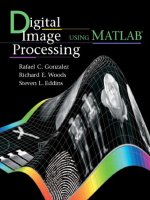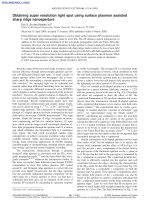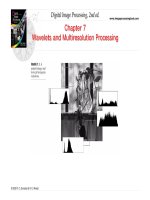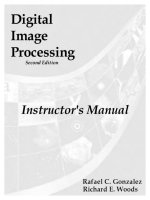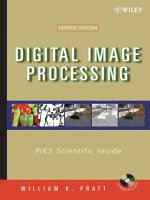Digital image super resolution
Bạn đang xem bản rút gọn của tài liệu. Xem và tải ngay bản đầy đủ của tài liệu tại đây (1.98 MB, 65 trang )
DIGITAL IMAGE SUPER RESOLUTION
LIU SHUAICHENG
(B.Sc., SICHUAN UNIVERSITY, 2008)
A THESIS SUBMITTED
FOR THE DEGREE OF MASTER OF SCIENCE
DEPARTMENT OF COMPUTER SCIENCE
SCHOOL OF COMPUTING
NATIONAL UNIVERSITY OF SINGAPORE
2010
Acknowledgements
First of all, I would like to express my sincere gratitude to my supervisor,
Assoc. Prof. Michael S. Brown, for his instructive advice and useful suggestions on my thesis. I am deeply grateful of his help in the completion of this
thesis. I am also deeply indebted to all my colleagues in Computer Vision
Laboratory, National University of Singapore. I really enjoyed the pleasant
stay with these brilliant people for the past 2 years. Special thanks should go
to my friends who have put considerable time and effort into their comments
on my thesis draft. Finally, I am indebted to my parents for their continuous
support and encouragement.
Contents
1 Introduction
1
1.1
Overview of Super Resolution . . . . . . . . . . . . . . . . . .
1
1.2
Thesis Objective . . . . . . . . . . . . . . . . . . . . . . . . .
3
1.3
Thesis Organization . . . . . . . . . . . . . . . . . . . . . . . .
4
2 Literature Survey
5
2.1
Interpolation Based Methods . . . . . . . . . . . . . . . . . . .
5
2.2
Reconstruction Based Methods . . . . . . . . . . . . . . . . .
8
2.2.1
Back Projection . . . . . . . . . . . . . . . . . . . . . .
8
2.2.2
Gradient Profile Prior . . . . . . . . . . . . . . . . . . 10
2.3
Learning Based Methods . . . . . . . . . . . . . . . . . . . . . 13
2.3.1
Example-based . . . . . . . . . . . . . . . . . . . . . . 13
3 Edge Prior and Detail Synthesis
18
3.1
Introduction . . . . . . . . . . . . . . . . . . . . . . . . . . . . 18
3.2
Reconstruction Framework . . . . . . . . . . . . . . . . . . . . 22
3.3
Gradient Field Estimation (∇p IH ) . . . . . . . . . . . . . . . . 24
3.4
Results . . . . . . . . . . . . . . . . . . . . . . . . . . . . . . . 30
1
CONTENTS
2
4 Addressing Color for SR
36
4.1
Introduction . . . . . . . . . . . . . . . . . . . . . . . . . . . . 36
4.2
Colorization Framework for SR . . . . . . . . . . . . . . . . . 39
4.2.1
4.3
4.4
Luminance Back-projection . . . . . . . . . . . . . . . 41
Colorization Scheme . . . . . . . . . . . . . . . . . . . . . . . 42
4.3.1
Image Colorization . . . . . . . . . . . . . . . . . . . . 43
4.3.2
Chrominance map generation . . . . . . . . . . . . . . 44
Results . . . . . . . . . . . . . . . . . . . . . . . . . . . . . . . 46
5 Conclusion
54
Chapter 1
Introduction
1.1
Overview of Super Resolution
Image super resolution (SR) is a process that estimates a fine-resolution
image from a coarse-resolution image. SR is a fundamentally important
research topic with the main purpose to recover sharp edges and estimate
missing high frequencies while suppressing other visual artifacts. Traditionally, there are both multiple-frame and single-frame variants in the SR [3].
In multiple-frame SR [9, 2, 25, 18, 36] a set of low resolution (LR) images
of the same scene are available. Usually, it is assumed that there is some
relative motion between the camera and the scene. Therefore, the first step
is to register or align these LR images. The high resolution (HR) image is
constructed from these aligned LR images by multiple-frame SR algorithms.
Single image SR [5, 7, 13, 15, 39] methods attempt to magnify the image with
the purpose of preserving edges or recovering missing details. These methods obtain missing information from the input image itself or other similar
1
Figure 1.1: An example of upsampling 3 ×, one pixel in the input image
corresponds to 9 unknow pixels.
images. This paper focuses on single image SR approaches.
Single image SR is necessary when multiple inputs of the same scene
are not available. As the number of the unknown pixels to be inferred is
much more than the size of the input data, the problem can be challenging. For example if we upsample an image by a factor of three, one pixel
in the input image corresponds to nine unknown pixels (see figure 1.1). In
the past years a wide range of very different approaches has been taken to
improve single image SR. They can be broadly classified into three families: (1) Interpolation-based methods,(2) Reconstruction-based methods, (3)
Learning-based methods.
Interpolation-based approaches [1, 29, 37, 24, 27, 17] have their foundations in sampling theory and try to interpolate the high resolution (HR)
image from the LR input. These approaches run fast and are easy to implement. However, they usually blur high frequency details and often have
noticeable aliasing artifacts along edges.
Reconstruction-based approaches [5, 7, 34, 39, 41, 38, 10] estimate an HR
2
image by enforcing some prior knowledge on the upsampled image. These
approaches usually require the appearance of the upsampled image to be
consistent with the original input LR images. This is achieved by back projection. The enforced priors are typically designed to reduce edge artifacts.
These types of methods are also referred to as edge-directed SR in this report. The performance of reconstruction based approaches depends on the
priors and its compatibility with the given image.
Learning-based approaches [13, 5, 15, 22, 33] are sometimes termed “image hallucination”. In learning-based SR, correspondences between low and
high resolution image patches are learned from a database consisting of low
and high resolution image pairs. The learned patches are applied to a new
LR image to recover its most likely HR version. The high frequencies of
the upsampled image which are learned from the training data are not guaranteed to be the true high resolution details. The performance of learning
based approaches depend on the effectiveness of the supporting image training database, especially for edges.
1.2
Thesis Objective
The objective of this thesis is to design algorithms for single image SR. Two
algorithms are proposed. The first algorithm named ’Super resolution using
Edge Prior and Single Image Detail Synthesis’ focus on the traditional single
image SR problem. Sharp edges and image details are recovered under large
zoom in factors. Another algorithm named ’Single image super resolution’
addresses color issues in single image SR and trying to handle color bleedings
3
which happens in many existing SR methods.
1.3
Thesis Organization
The remainder of this paper is organized as follows: in Chapter 2, we survey
a variety of techniques and provided a tentative classification according to
their properties; in Chapter 3, the proposed algorithm of SR named ’Super
resolution using Edge Prior and Single Image Detail Synthesis’ is discussed in
details. A method for addressing color in SR, is given in Chapter 4. Chapter
5 concludes the thesis.
4
Chapter 2
Literature Survey
2.1
Interpolation Based Methods
Interpolation is the process of determining the values of a function at positions lying between samples. Common used interpolation methods include
nearest neighbor, bilinear, bicubic. Super resolution through these simple
interpolation method is computational efficient and is widely used in image
processing software.
Nearest neighbor
The simplest interpolation method is nearest neighbor (pixel replication),
where each interpolated output pixel is assigned the value of the nearest
sample point in the input image. The kernel of nearest neighbor interpola-
5
tion is defined as:
1
h(x) =
0
0 ≤ |x| < 0.5,
0.5 ≤ |x|,
The kernel h(x) helps to decide which neighbor values to choose at the interpolated position based on the |x|. The term |x| refers to the distance between
the given position and a specific neighbor. Due to the fact that nearest neighbor interpolation simply copy the nearest pixel, a jaggy artifacts is obvious.
Linear Interpolation
Linear interpolation is a method of curve fitting using linear equations. Unlike the nearest neighbor method, the interpolated pixel value is computed
by its neighbors. The kernel of linear interpolation is defined as:
1 − |x|
h(x) =
0
0 ≤ |x| < 0.5,
1 ≤ |x|
For the 2D case , bilinear interpolation is used where four neighbors are considered for the interpolated value. Linear interpolation produces reasonably
good results, but still tend to blur edge detail.
Cubic convolution
The cubic convolution interpolation kernel is composed of a piecewise cubic
polynomials defined on the subintervals (-2,-1),(-1,0),(0,1),(1,2). Outside the
interval (-2,2), the interpolation kernel is zero. Compared to the linear in-
6
(a)
(b)
(c)
(d)
Figure 2.1: Example of interpolation based methods. (a) low resolution
image. (b)Nearest neighbor 4x. (c)Linear interpolation 4x. (d)Cubic interpolation 4x.
terpolation, more samples are used to compute the newly interpolated value.
The kernel is defined as:
(a + 2)|x|3 − (a + 3)|x|2 + 1
h(x) =
a|x|3 − 5a|x|2 + 8a|x| − 4a
0
0 ≤ |x| < 1,
1 ≤ |x| < 2,
2 ≤ |x|
The performance of the interpolation kernel depends on a. For different images, different values of a gives the best performance. Cuibc interpolation is
more computational expensive compared to linear and nearest neighbor interpolation. However, the results are smoother and have fewer interpolation
artifacts.
7
2.2
2.2.1
Reconstruction Based Methods
Back Projection
Back projection (BP) [19, 6] is an efficient algorithm which minimize the
reconstruction error with an iterative procedure. It is widely used in SR
algorithms. Back projection makes the reconstructed HR image consist with
the input LR image. The main contribution of back projection is that the
reconstructed HR have the same look and feel as the LR image after applying
BP. Usually, a BP algorithm is used together with other super resolution
algorithm to enhance the SR result during the reconstruction phase or at the
final step.
Back Projection algorithm
The generation process of producing a LR image can be modeled by a combination of the blur effect and the down-sampling operation as shown in [3].
By simplifying the blur effect with a single filter g for the entire image, the
generation process can be formulated as follows:
I l = (I h ⊗ g) ↓s ,
(2.1)
where I l and I h are the LR and HR images respectively, ⊗ represents convolution with filter g, and ↓s is the down-sampling operator with scaling factor
s.
The Back Projection algorithm can be summarized as iteratively updating
HR image to minimize the reconstruction error. The algorithm is described
8
as follows:
• Compute the LR error: Error(Ith ) = Itl − (Ith ⊗ g) ↓s
• Update the HR image by back-projecting the error as follows:
h
= Ith + Error(Ith ) ↑s ⊗p
It+1
where Ith is the HR image at the t-th iteration, ↑ is the upsampling operator,
p is a constant back-projection kernel. These two steps are computed iteratively until the reconstruction error Error(Ith ) drops under a given threshold.
During each iteration, the current reconstruction error is back-projected to
adjust the image intensity. By updating the HR image with back-projection
iteration, Ith will converge to a desired image which satisfies Eqn. 2.1
Bilateral Back Projection
The algorithm described above can produce visually appealing result, however, this method suffers from the chessboard effect and ringing effect, especially along strong edges. The underlining reason is that there is no edge
guidance in the error correction process. During each iteration , the LR error
Error(Ith ) is back-projected to HR image by a isotopic kernel p. The error
correction step propagates the error without considering the local edge direction and strength. The cross-edge error propagation may produce ringing
effect, and the isotropic kernel results in chessboard effect.
Bilateral back projection [6] using a bilateral filter during the back projection process. Bilateral filter is a non-linear filtering technique which can
combine image information form both of the space domain and the feature
domain in the filter process. Rather than simply replacing a pixel’s value
9
(a)
(b)
(c)
(d)
Figure 2.2: Example of back projection algorithms [6]. (a) low resolution
image. (b)Back projection 4x. (c)Bilateral back projection 4x. (d)Ground
truth.
with a weighted average of its neighbors, as for instance the Gaussian filter
does, the bilateral filter replaces a pixel’s value by a weighted average of its
neighbors in both space and range,thus the edge sharpness is preserved by
avoiding the cross edge smoothing.
The main difference between simple BP and bilateral BP is that the
bilateral filter is applied on the HR error image Error(Ith ) ↑s during each
iteration. For homogeneous regions , the bilateral BP algorithm is the same
as the simple BP, for regions near step edges, the error will be only propagated
in the part on the sides of the edges. With bilateral BP, clear and sharp edges
are obtained compared to simple BP.
2.2.2
Gradient Profile Prior
The Gradient Profile Prior [39] is a parametric prior describing the shape
and the sharpness of the image gradients. Unlike previous smoothness prior,
the gradient profile prior is not a smoothness constraint. Both small scale
and large scale magnification can be well recovered. The common artifacts in
super resolution, such as ringing artifacts can be avoided by working in the
gradient domain using the gradient profile prior. The reconstructed gradient
10
Figure 2.3: (a)Two edges with different sharpness. (b)Gradient map, p(x0 )
is a gradient profile.(c)1D curves of two gradient profiles. Image from [39].
field is much closer to the ground truth gradient field. Generally, SR through
the gradient profile constraints produces results with sharper edges than
other techniques. Fig.2.3 from [39] shows an example of gradient profile of
p(x0 ) with different sharpness.
The gradient profile p(x0 ) is a 1-D profile along the gradient direction of
the zero-crossing pixel in the image. The gradient profile prior is a parametric distribution describing the shape and the sharpness of the gradient
profiles in natural image. One observations is that the shape statistics of the
gradient profiles in natural image is quit stable and invariant to the image
resolution. With this stable statistics, statistical relationship of the sharpness of the gradient profile between the HR image and the LR image can be
learned. Using the learned gradient profile prior and relationship, we are able
to provide a constraint on the gradient field of the HR image. Combining
11
Figure 2.4: (a) LR image and its gradient field. (b) result of back-projection
and its gradient field. (c)GPP result and its gradient field. (d) ground truth
image and its gradient field. Image form [39]
with the reconstruction constraint, hi-quality HR image can be recovered.
Figure 2.4 gives an example of GPP method. Figure 2.4(a) are input
LR image and the gradient field of bicubic upsampled image. Figure 2.4(d)
are ground truth HR image and its gradient field. Figure 2.4(b) are backprojection result using the reconstruction constraint only. The bottom image
in Figure 2.4(c) is GPP transformed gradient field. The transferred gradient
field is used as the gradient domain constraint for the HR image reconstruction. As we can see, the transformed gradient field Figure 2.4(c) is much
closer to the ground truth gradient Figure 2.4(d).
12
2.3
2.3.1
Learning Based Methods
Example-based
The interpolation-based image SR (bilinear, bicubic) usually result in the
blurring of images. While edge directed interpolation can preserve the edges
to some extent, it still suffers from lost of image detail in homogenous regions.
Example-based SR [13] tries to recover the lost high frequency details. The
recovered plausible high frequency comes from a database which consists of
a set of training images. Example-based SR is the most important learningbased approach which has inspired many other learning-based algorithms.
Training Set
The training set contains a set of HR and LR image pairs. The LR image
is generated by down sampling the corresponding HR image. It is believed
that the highest frequency components of the low resolution image are most
important in predicting the extra details. The low frequency are filtered out
and only the high frequency component are stored. The low resolution patch
has the size of 7 × 7 and the corresponding high resolution patch size is 5 × 5.
The reason why the LR patch size is bigger than its HR counterpart is that
big patch can capture more spatial information than small ones. Fig.2.5
from [13] shows the pre-processing steps for the training set generation. LR
image Fig.2.5(a) is a down sampled version of original image(c). Fig.2.5(b) is
the interpolation version of (a). Images (b) and (c) becomes a pair of image
pairs in the pixel domain. Band-pass filtering and contrast normalizing (b)
get (d). Fig.2.5(e) is high frequency of (c). Training set stores corresponding
pairs of patches from (d) and (e).
13
Figure 2.5: Training set images generation. (a)Low resolution input image. (b)initial cubic interpolation image. (c)orginal full frequency image.
(d)Band-pass filtered and contrast normalized of (b). (e)True high frequencies of (c). Image from [13]
Markov network model
The local image information alone is not sufficient to predict the missing
high resolution details. If we take a look at a input patch and its K nearest
patches searched in the database, it is easy to find that although the K
nearest patches are similar to the input patch and also have a similar look
between each other, the corresponding HR patches are quite different from
each other. This indicates that a nearest neighbor algorithm is not sufficient
, spatial context must also be considered. The spatial relationships between
patches are modeled as a Markov network shown in Fig.2.6 [13]. The term y is
the observed node corresponding to the interpolated version of input image
and x is the underlying scenes. The term yi and xi refer to LR patches
and HR patches respectively. Each observed node yi has many underlying
14
Figure 2.6: Markov network model for example-based super resolution. Image from [13]
candidate scenes by K nearest neighbor search in the training set. For the
MRF, the joint probability over the scenes x and observed images y can be
written as:
P (x1 , x2 ..., xN , y1 , y2 ..., yN ) =
Ψ(xi , xj )
i,j
Φ(xk , yk ) ,
(2.2)
k
where (i, j) indicates neighboring nodes i,j and N is the number of image
and scene nodes. The term Ψ and Φ are pairwise compatibility functions
where Φ is data cost and Ψ is smoothness cost in the MRF model. Data cost
Φ is defined as the Euclidean distance between the input image patches and
patches extracted from LR images in the training set. A K nearest neighbor
search algorithm is used for each node. To specify smoothness constraint Ψ,
the nodes are sampled from the input image so that the HR patches overlap
with each other by one or more pixels. Let dljk be a vector of the pixels of the
l-th possible candidate for scene patch xk which lie in the overlap region with
patch j. Likewise, let dm
kj denote m-th candidate vector. We say that scene
candidates xlk (candidate l at node k) and xm
j are compatible with each other
if the pixels in their overlap regions agree. The term Ψ defines compatibility
15
Figure 2.7: A single pass algorithm without MRF. Image form [13]
of node k and j defined as:
l
m 2 /2σ 2
s
−|djk −dkj |
Ψ(xlk , xm
j ) = exp
,
(2.3)
We say that a scene candidate xlk is compatible with an observed image patch
y0 if the image patch ykl in the training database matches y0 .
l
Φ(xlk , yk ) = exp−|yk −y0 |
2 /2σ 2
i
,
(2.4)
The MRF model can be solved by Belief Propagation [21]. For each node xi a
compatible patch is found from the training database by solving the Markov
network. The result is reconstructed by these patches.
An algorithm without MRF
Fig.2.7 from [13] illustrates an algorithm of example-based SR without introducing the Markov network while still preserving the smooth constraint. The
algorithm is more efficient than solving the Markov network. The algorithm
16
(a)
(b)
(c)
Figure 2.8: Example of learning based methods. (a) Low resolution image.
(b)Cubic interpolation 4x. (c)Learning 4x.
works in raster-order from left to right and top to bottom. At each step the
search vector is formed by the LR input and the overlap region of previous
selected HR patches. The training data is also generated by concatenated
vectors. Therefore, the nearest search in the training set is not only trying
to find the underling sense patch for each xi but also trying to find the most
compatible patch with previous generated patches.
17
Chapter 3
Edge Prior and Detail
Synthesis
3.1
Introduction
As previously mentioned, approaches addressing the SR problem can be categorized as interpolation based, reconstruction based(edge-directed), and statistical or learning based (for a good survey see [44]).
The major drawback of edge-directed SR approaches is their focus on
preserving edges while leaving relatively “smooth” regions untouched. As
discussed in [3, 31], if a SR algorithm targets only edge preservation, there
exists a fundamental limit (about 5.5× magnification) beyond which high
frequency details can no longer be reconstructed. Loss of these details leads
to unnatural images with large homogeneous regions. This effect is demonstrated in Figure 3.1 that plots the gradient statistics of SR images with
different magnification factors. Shown are bicubic upsamling (b) and edge18
directed SR [39] (c). The respective gradient statistics plots shown in Figure 3.1(d-e) increasingly deviate from the heavy-tailed distribution of natural
image statistics [11] as the magnification factor increases.
To produce photo-realistic results for large magnification factors, not only
must edge artifacts be suppressed, but image details lost due to limited resolution need to also be recovered. Learning based techniques can achieve the
latter goal; however, as mentioned in many previous works, the performance
of learning based SR depends heavily on the similarity between training data
and the test images. In particular, the quality of edges in the SR image can
be significantly degraded when corresponding edges in the training data do
not match or align well. Accurate reconstruction of edges is critical to SR,
as edges are arguably the most perceptually salient features in an image.
We propose an approach that reconstructs edges while also recovering
image details. This is accomplished by adding learning-based detail synthesis to edge-directed SR in a mutually consistent framework. Our method
first reconstructs significant edges in the input image using an edge-directed
super-resolution technique, namely the gradient profile prior [39]. We then
supplement these edges with missing detail taken from a user-supplied example image or texture. The user-supplied texture represents the look-and-feel
that the user expects the final super-resolution result to exhibit. To incorporate this detail in a manner consistent with the input image, we also identify
significant edges in the example image using the gradient profile prior, and
perform a constrained detail transfer that is guided by the edges in the input
and example images.
While similar ideas have been used for single image detail- and style19
(a)
(b)
(c)
(d)
(e)
Figure 3.1: Gradient statistics of HR images using increasing magnification.
(a) Input LR image; (b) 10× upsampling using bicubic interpolation; (c)
10× upsampling by edge-directed SR [39]; (d,e) gradient statistics for bicubic interpolation and edge-directed SR with 1× to 10× upsampling. For
greater levels of magnification, the gradient statistics increasingly deviate
from natural image statistics [11].
transfer (e.g. [16, 8, 35]), our approach is unique in that it is framed together
with edge-directed SR. This gives the user flexibility in specifying the exemplar image – we can still obtain quality edges in the upsampled image even
if they are not present in the example image. Experimentally, our procedure
produces compelling SR results that are more natural in appearance than
edge-directed SR and are on par or better than learning based approaches
that require a large database of images to produce quality edges. This is
exemplified by the images in Figure 3.2.
20
(a)
(b)
(c)
(d)
(e)
Figure 3.2: Example-based detail synthesis. (a) 3× magnification by nearest
neighbor upsampling of an input low resolution (LR) image with a user supplied example image; (b) result using edge-directed SR [39]; (c) result from
our approach that synthesizes details from the input example. The region
where detail is transferred is shown in the lower right inset; (d) ground truth
image; (e) 10× magnification using our approach. The example texture was
found using Google image search with the keyword “monarch wing”.
21

